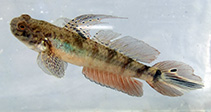| Family: |
Gobiidae (Gobies), subfamily: Gobionellinae |
| Max. size: |
15 cm TL (male/unsexed) |
| Environment: |
demersal; freshwater; brackish; marine, amphidromous |
| Distribution: |
Western Atlantic: Chesapeake Bay, USA and northern Gulf of Mexico to northern South America; absent in the Bahamas, but present in Greater Antilles. |
| Diagnosis: |
Dorsal spines (total): 6-6; Dorsal soft rays (total): 11-11; Anal spines: 0-0; Anal soft rays: 12-12. Caudal fin large and bluntly pointed with dark lyre-shaped mark on base consisting of 2 dark spots separated by pale central area. Snout very short, mouth small and inferior. Adults have first 3 or 4 dorsal fin spines elongate, reaching from third to sixth ray of second dorsal in females, to base of caudal peduncle in males. Predorsal area and top of head scaled as far forward as eye (Ref. 26938). |
| Biology: |
Occur mainly in muddy backwaters of bays and estuaries, often in foul waters. Also found on muddy bottoms of fresh water (Ref. 13628). |
| IUCN Red List Status: |
Least Concern (LC); Date assessed: 12 February 2019 Ref. (130435)
|
| Threat to humans: |
harmless |
Source and more info: www.fishbase.org. For personal, classroom, and other internal use only. Not for publication.

